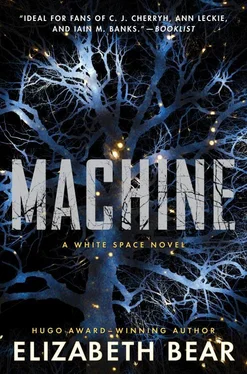Afar was under gravity from the spin of the generation ship he was docked to, but it was obvious that he was not designed to spend much time that way. And because I was trying to track several perspectives at once, I couldn’t get an accurate count of the crew members.
If Sally’s—and the drones’—ability to register the faint, regular, painfully slow respiration of Afar’s crew hadn’t told me they were alive, I would have thought they were dead. They were utterly motionless—and very beautiful—crystalline icicle sculptures. They would have been radially symmetrical if they had not been slumped in awkward poses, limbs folded under their bodies, frost-flower spikes jutting at regular angles from carapaces.
They lay against what were obviously designed to be zero-g bunks and acceleration couches, crystalline bodies padded by what I took to be some kind of low-temperature aerogel. The material technologies are so utterly different from ox-based ones that there’s no comparison. In what they consider room temperatures, the oxygen and carbon dioxide of our atmosphere would precipitate out of the nitrogen as snow. And methane would puddle in lakes.
Going in there scared me. Space is cold, too—but in space, there’s no convective or conductive cooling. A methanogen environment (even though the atmosphere, like mine, would be mostly nitrogen) would suck any heat it could reach out of me, and then use that heat to kill the people I had come to save.
We couldn’t bring them back to Sally. She had environmental chambers, but nothing that could manage this syster’s needs.
“I’m willing to try it,” I said. “A fast packet? How many crew, four?”
“Five,” Sally said.
Helen said, “You will not endanger my crew.”
“No,” said Tsosie. “We will not. Anyone else have any comments?”
“We’ve got ayatanas for that species,” Rhym said.
Do you ever get the sense that nobody is listening to you? “I know,” I said again. “I’m wearing one.”
Rhym continued, “I, too, can wear one, and can operate by remote if necessary.”
“It would be most efficient to leave them on their own ship and tow them in,” said Hhayazh. “No, wait. Slave the drive and bring them in that way, since their ship can keep up with Sally. Sally, you said you could not contact Afar at all? Even emergency protocols? A consciousness ping?”
“That is correct,” Sally said. “We’d need to hardwire in an override panel.”
“I can do that,” I said. “Pass me the solder that’s still good at negative 190C.”
Loese leaned back in her chair. “It’s feasible.”
“And somebody has to set up life support to keep the crew alive while we’re in transit.” I checked my Darboof ayatana for more physiology. “Unless Rhym wants to use drones to do it?”
“As I offered, I will also load some Darboof ayatanas,” they replied. “Then we can decide whether their own metabolic processes are protecting them enough to get them back to Core General alive. They can be slowed down, if I recall; the environment they evolved in is so cold that their strictly chemical biology moves at a very slow pace.”
“They’ve only survived this long because their metabolisms are seriously depressed. That’s why they’re still breathing,” I said. “It’s only electrical signals that keep them functioning at anything like meat speed.”
I stole a glance at Helen again. She still sat completely silent, but she seemed to be aware. I took a breath and said, “Isn’t it odd that two ships in the same place, with very different architectures and design histories, both seem to have lost their shipminds?”
Sally cleared her nonexistent throat. “To say lost is factually inaccurate.”
“Granted.” I didn’t roll my eyes because Sally would know what it meant. And because Helen was sitting right there, and I’m not a complete jerk. “Of course Big Rock Candy Mountain ’s shipmind is not missing. Considering my question idiomatically, is it odd?”
“Yes,” Sally answered. “It is.”
“I wish we could know if they suffered damage in similar ways,” Camphvis said. “It seems very unlikely; modern AI architecture is quite dissimilar from what your species used in the sublight age.”
“Right,” I said. “Sally, are you planning to take direct control of Afar? I guess we need to cut him loose from Big Rock Candy Mountain and remotely bring him home.”
“I’m concerned about contagion,” she said, “given that we have two shipminds damaged by possibly connected phenomena. But since I’m already in contact with the machine, it may be closing the bay door after the pirates have flown in to worry about viruses now. And the alternative is to physically grapple him.”
“It’ll be easier for me to get over there if he’s not whirling around with the wheel, having made that jump already. But it’s your call. I can undock him manually.”
“No,” Sally said. “If you’re willing to take the risk, I can plug in a drone and make things nice and easy with matched velocities. You don’t even have to go over and, as you so kindly offered, solder on a panel. Just handle a life-support setup for the crew while we’re in transit.”
“You’re very accommodating,” I joked. “What if Afar is contagious?”
“I have a personality core backup on archive at Core General,” she answered. “And I have good firewalls. If you meat types are willing to take the small additional risk, I am. The worst I stand to lose is a few diar of memories. You could wind up drifting forever in the interstellar darkness.”
I laughed.
But maybe a little nervously.
_____
Our IR scanners and the drones showed Afar was cold—cold, cold, cold—but that didn’t mean the crew was dead. Cold was the only habitat methane breathers could endure.
I got Sally to give me two more ayatanas from Core General staff who belonged to Afar’s crew species. As Sally had previously demonstrated, the Darboof’s name for themselves sounded like the chiming of glass bells; their sensorium experience was foreign to mine. Even though I unloaded a couple of the antique human ayatanas first, downloading and integrating the recorded memories of two more from the Darboof strained my capabilities enough that I found myself looking at the brown squishiness of my own fingers with disgust. I was revoltingly unlike the clean, crystalline purity of the methane breathers. Wet, dangerously hot, full of terrifying caustic fluids…
Right. I tuned myself to manage my increasingly catastrophic endocrine response and felt the pulse rate of my (hot, caustic-blooded) heart slow.
Better living through brain implants!
Calmer, I settled in to research in my borrowed memories. Since the ayatanas in question were those of medical professionals, I was able to find the information I needed fairly quickly.
That infrared reading suggested they hadn’t gotten too hot: their climate control was still working. The vessel’s hull seemed intact per visual inspection and the drone report, so there probably hadn’t been any impacts. And, I reminded myself, the drones said the crew were alive in there, just in some kind of suspension.
Which led me to the least reassuring detail I learned from my recorded passengers. I reaffirmed my earlier impression that the Darboof did not, in general, exhibit a hibernation response to trauma, though there was some evidence that one could be induced in them by the right combination of interventions. That would require the equivalent of putting me in a cryo tank, though, so I didn’t think it was what had happened here.
The Darboof were physically tough, able to withstand more gs than squishy little critters like myself, and they didn’t demineralize in free fall, either. Lucky. Being under simulated gravity for however long they had been docked—not too long, since they were still alive and respiring, per the drones—wouldn’t have harmed them.
Читать дальше












